Types of Hair Loss
There are many types and causes of hair loss. Keep in mind that the term “Alopecia” simply means hair loss. The term alopecia does not describe any type, pattern or cause of hair loss. Sometimes, the term alopecia is combined with other terms to denote a specific type of hair loss, and these will be discussed below.
Androgenetic Alopecia
The most common type of hair loss is properly known as Androgenetic Alopecia (AGA). Commonly it is also known by various other names such as “Male Pattern Baldness”, “Female Pattern Hair Loss”, “Pattern Hair Loss”, “Genetic Hair loss”, etc. In this case the term for hair loss, “alopecia”, is combined with other terms denoting the cause of the hair loss. As its name suggests, AGA is caused by a genetic pre-disposition where hair follicles in the scalp are susceptible to a specific androgenic hormone in the body. The androgen testosterone, when bound by the enzyme 5-alpha-reductase, produces another androgen called DHT. It is this powerful hormone that contributes to pattern hair loss in both men and women. However, how it effects men and women are quite different, and ironically, the same hormone is responsible for the production of hair during puberty.
In men, AGA can begin as early as the mid teens and continue well into later life, although most men will begin to experience it in their mid 30’s, if they are genetically pre-disposed. In women, AGA can be complicated and aggravated by many other factors. Changes in levels female hormones like estrogen and progesterone can affect the dominance of testosterone and DHT. Thyroid and Adrenal gland imbalances are common contributors to hair loss in women. Also very common in women are deficiencies in Iron and Vitamin D, both of which can contribute to AGA and a more generalised type of hair loss known as Telogen Effluvium, discussed below.
Recently it has been discovered that inflammation, long associated with other types of hair loss, may also play a key role in AGA, so new protocols in hair loss treatment should include a plan to reduce inflammation in the scalp.
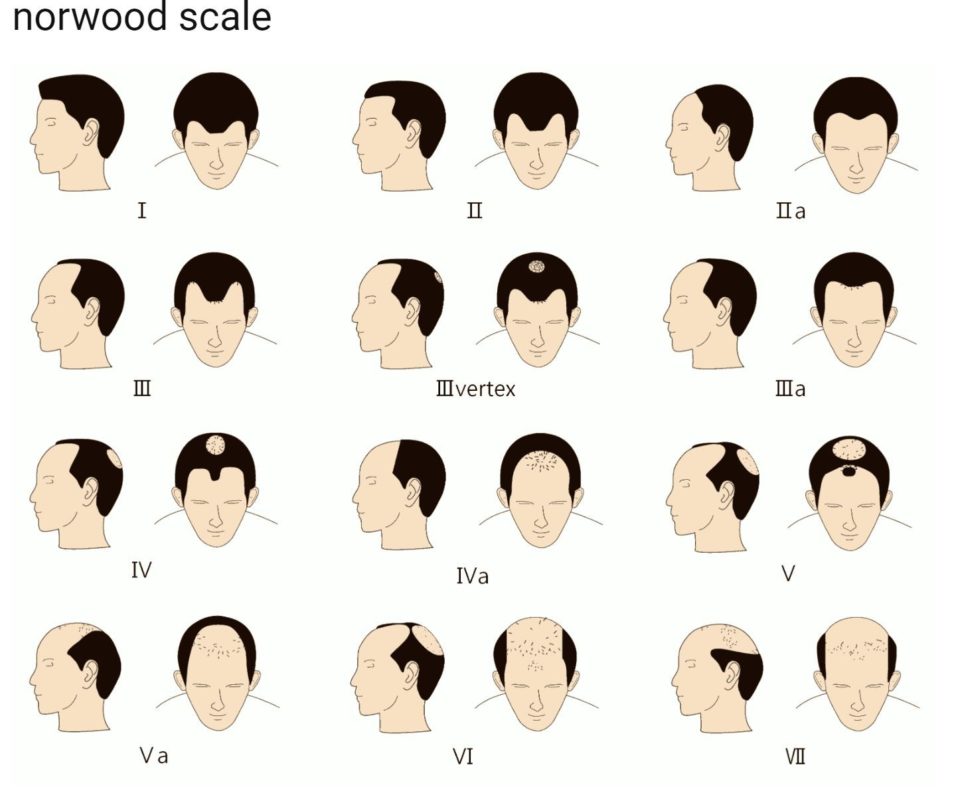
Male Pattern Hair Loss
As mentioned above, AGA in men can begin as early as the teens. Usually, when AGA starts in these younger years, the extent of the hair loss will most likely be considerable by the time the person has reached their mid 30’s. The most common progression and patterns are represented by the Norwood Scale of Male Androgenetic Alopecia.
Patterns of AGA in men can and do differ from this scale, and not everyone will progress through the entire scale. Many men will lose a bit of hair in the temples and never any more than that.
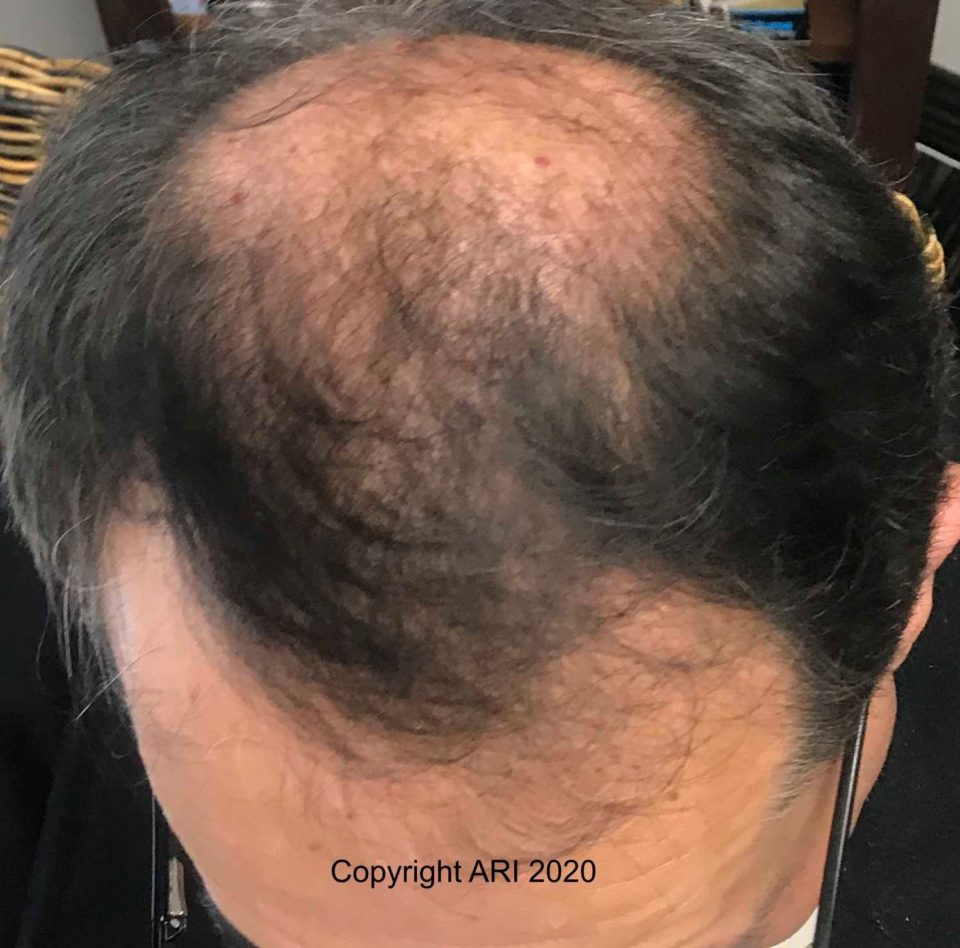
The progress of hair loss in AGA is one of thinning, rather than loss. As hair begins to be affected by DHT, the hair follicles are reduced in size, and therefore produce smaller and finer hairs. These hairs become finer as they fall out and replace themselves. This is known as “miniaturization”. Another symptom of AGA is the shortening of the hair growth cycle. As hair loss progresses, the finer hairs will have a shorter time period from when they start growing and when they fall out. Finally, the length of the resting stage (both telogen and kenogen) can also be increased, leading to areas where hair is not growing. It is important to note that hair follicles in the kenogen stage are not necessarily dead, and the goal of many hair loss treatments is to return these follicles to the anagen stage, and reduce the length of the telogen and kenogen stages.
Female Pattern Hair Loss
Similar to AGA in men, AGA in women involves the miniaturization of hair follicles. In more advanced hair loss, extensive lengthening of the kenogen stage will present as larger spaces between the hair follicles. Generally speaking, AGA in women affects the top of the head. When hair loss progresses extensively down the sides and back of the scalp, there is usually more than just genetics involved. Nutritional deficiencies, hormone imbalances, stress, medications, medical conditions – all of these factors are common exacerbations of AGA in women. AGA in women often spares the frontal edge of the hairline, and the hair loss shows up more in the central regions of the scalp. However, it is also common to encounter women suffering from extensive hair loss in the frontal hair line, and down the sides and back of the scalp. Again, in these cases, there are likely other factors involved in the hair loss, and the approach in this case should be an in depth trichological analysis [link to trich analysis page] to help determine what other factors may be involved in the hair loss.
Alopecia Areata, Alopecia Totalis, and Alopecia Universalis
These types of hair loss are grouped together because they have the same cause: They are all caused by an auto-immune disorder in which white blood cells attack the melanin in hair follicles. This causes the hair to snap off within the hair follicle or at the surface, while the follicle enters an extended telogen stage. Often, black dots will appear on the surface of an affected area where the hair has broken off. As well, exclamation mark hairs may appear on the scalp. These are short hairs that are thinner and often less pigmented near the skin, gradually thickening on the way up the shaft. This is due to the white blood cells attack on the melanin within the hair follicle. Usually, affected follicles will go into dormancy and remain there indefinitely, until, unpredictably, they will begin to produce hair again. Although the cause of the hair loss is a type of inflammation, the skin in the affected areas of the scalp and body appears smooth and unremarkable in any way, and the hair follicles can return to anagen at any time. What causes the follicles to return to anagen or triggers the body to attack the melanin is not totally understood, but several factors are commonly present in active stages of these types of alopecia.
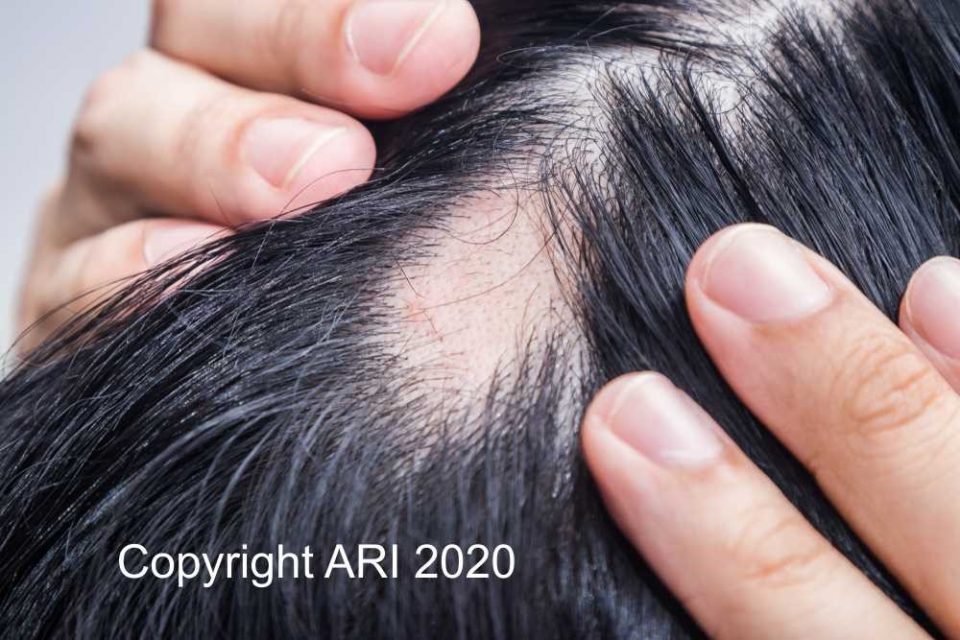
Alopecia Areata
The difference between these three types of alopecias are the location on the body and the extent of the hair loss. In Alopecia Areata, patches or areas of hair loss occur. Commonly they are located on the scalp, but they can frequently show up in men’s beards, or other areas of the body. The frustrating thing about Alopecia Areata is the tendency of the condition to come and go, and of the patches of hair loss to migrate. Usually, the patches lead to complete hair loss in the area. The patch may start small and progress to a larger area, or patches may appear scattered throughout the scalp. These patches can remain without hair indefinitely, and suddenly regrow, while other areas may begin to lose hair. The longer the patches stay in dormancy, the more permanent they seem to be, although the hair loss is never truly permanent.
Alopecia Totalis
Alopecia Totalis is hair loss of the same cause as Alopecia Areata, however the hair loss occurs on the entire scalp, usually including the eyebrows and eyelashes. Again the hair can begin to regrow at any time unpredictably, and partial regrowth is also quite common.
Alopecia Universalis
This condition is the same as Totalis and Areata, except that the hair loss occurs throughout the entire body.
In all of the above conditions, the hair follicles do not die, but simply remain in dormancy. They therefore retain the capacity to regrow at any time.
Scarring Alopecias – Cicatricial Alopecia
Scarring Alopecias are also auto-immune conditions, where inflammation leads to hair loss in the affected areas. The main characteristic in these types of alopecia’s is that the inflammation leads to scarring of the skin in the affected area, which leads to complete destruction of the hair follicles and stem cells and thus permanent hair loss. There is very little chance, if any, of the hair ever growing back. The inflammation is usually quite apparent in the affected areas of the scalp while the disease is active. These types of alopecias affect both men and women, although some of them are more predominant in women of post menopausal age. With these types of alopecia, the goal of treatment is to stop the spread of the hair loss. There are many types of scarring alopecia. Some of the common ones are listed below.
FFA – Frontal Fibrosing Alopecia. This scarring alopecia affects the forehead and temple areas. It usually leads to complete hair loss in these areas. It can also include the eyebrows.
LPP – Lichen Planopilaris. Usually starts in the crown as patches and can spread throughout the scalp.
FD – Folliculitis Decalvans. Similar to LPP, with clear signs of inflammation and distress to the hair follicles. Hairs often appear in tufted groups in affected areas.
DLE – Discoid Lupus Erythematosus. This type of scarring presents with scaling and inflammation in the affected areas.
CCCA – Central Centrifugal Cicatricial Alopecia. This is common among African American Women and although it is also an auto-immune condition it is also associated with tight braiding of the hair and/or chemical treatments.
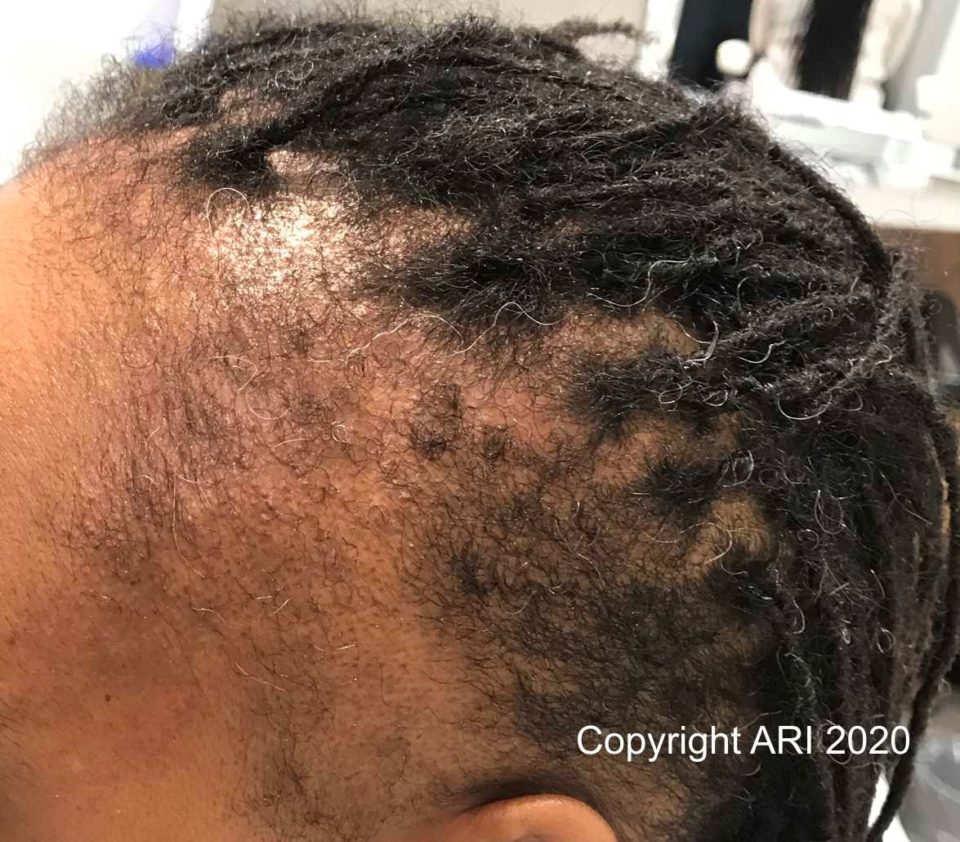
Hair Loss due to Mechanical Tension – Traction Alopecia
When pro-longed tension is placed on the hair roots a type of hair loss can occur called Traction Alopecia. This type of hair loss is common with people who braid their hair in tight braids over a long period of time. It can also occur if ponytails are tied too tight. Hair system attachment methods can also cause traction alopecia, if the person’s own hair is used to anchor the hair system. The pro-longed tension in these cases damages the hair follicles to the point where they can no longer produce hair, or produce only fine short hairs.
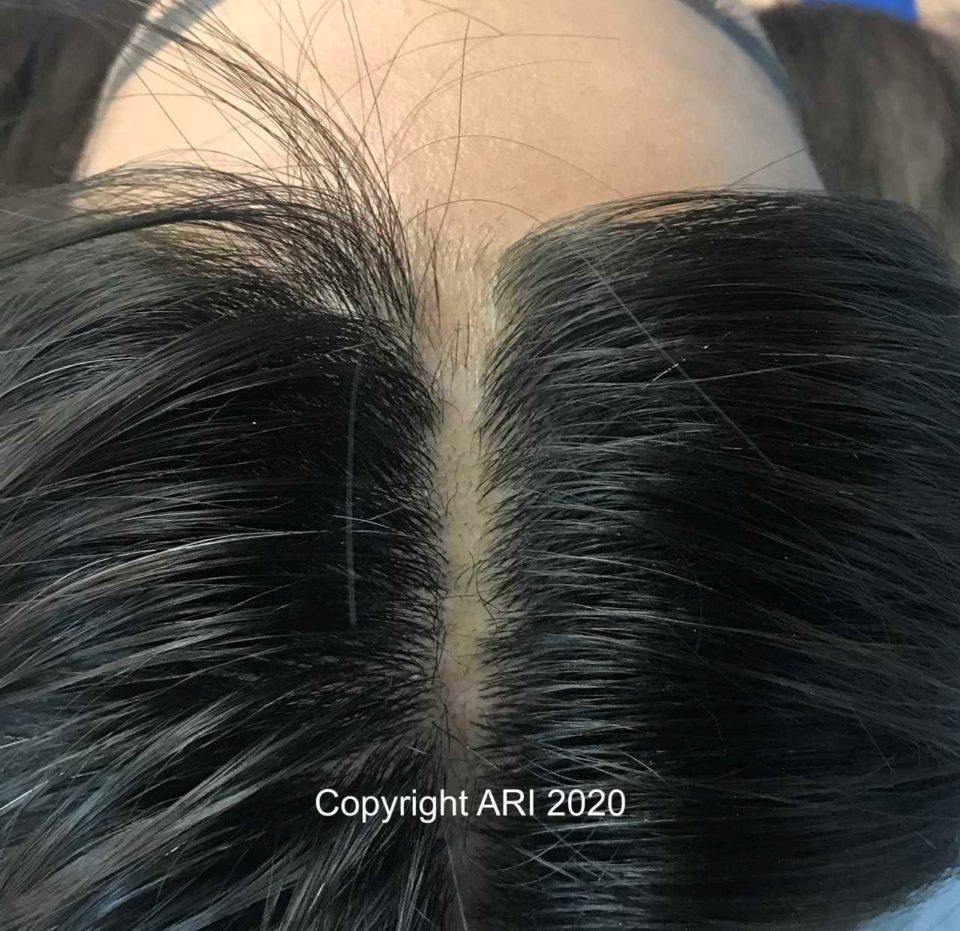
Trichotillomania
is a nervous condition some people suffer from which causes them to pull their own hair out. Patients suffering from this condition often feel pleasure from the tension they put on their hair, and controlling the urge to pull the hair out is difficult. Often the hair loss is not permanent, so affected areas may show signs of regrowth. However, there is a risk of traction alopecia in these areas, and often patients will continue to pull the same area once the hair grows back in, increasing the risk of traction. We have used scalp micro-pigmentation on patients with trichotillomania and found that in some cases, the treatment may halt the patient’s desire to pull in that area. It seems the knowledge that a treatment has been done in a specific area has the psychological benefit of stopping the pulling from that area. In one case, we saw complete regrowth of the pulled area after treatment with SMP.
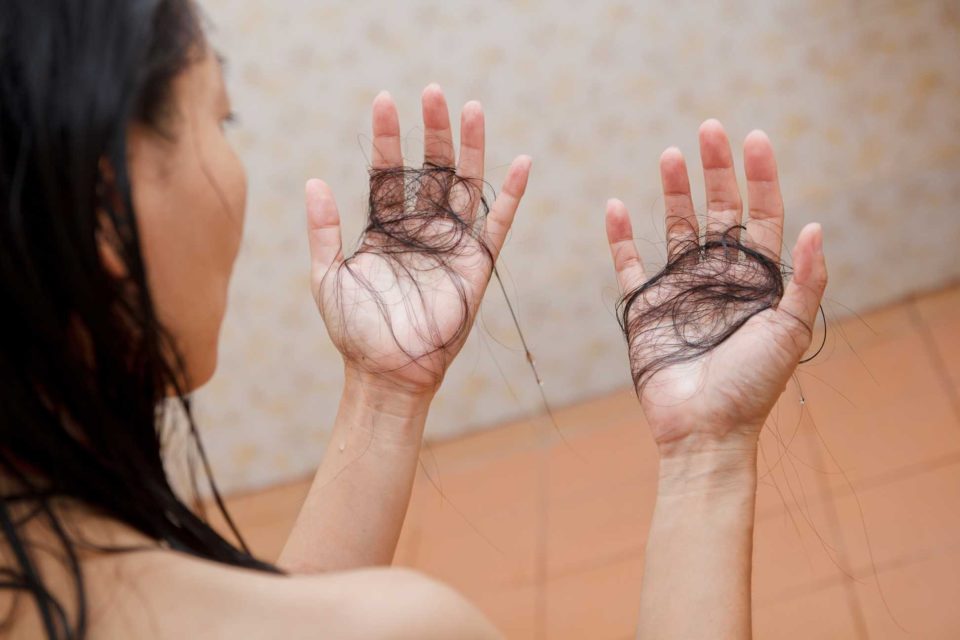
Telogen Effluvium
Telogen Effluvium is a type of hair loss that occurs due to many reasons. As its name suggests, Telogen Effluvium occurs when large numbers of growing hairs suddenly enter the telogen phase, causing rapid hair loss throughout the scalp. This type of hair loss will always resolves itself, even when the cause is unknown, but only when the cause is removed. TE can be caused by physical or emotional stress. Physical stressors can include medication changes, surgery, a fever, hormonal imbalances, nutritional changes, etc. The hair loss usually occurs about 3 months after the stressful event, and will begin to resolve itself about 3 months after the resolution of the event, or once the cause has been removed.
Diffuse hair loss or thinning Hair
after pregnancy is the result of the hormonal changes in a woman’s body. This is a type of Telogen Effluvium, however this type of hair loss frequently aggravates or triggers AGA in women who are pre-disposed to AGA. Women will often note an increase in hair growth prior to giving birth. This is because the increase in female hormones when pregnant counteracts the male hormones responsible for hair loss. After the child is born, and female hormones return to normal, the effect of male hormones on hair growth increases. Often, the hair loss or thinning hair after giving birth continues for the long term. Microscopic evaluation will reveal miniaturisation of hairs in these cases. This is a clear indication the that hair loss, originally triggered by the change in hormones, is actually AGA.
Determining the cause of your hair loss can be simple or complex. In some cases, detailed analysis of nutrition, lifestyle, life events, blood tests and hair and scalp condition and maintenance all need to be performed. Other symptoms are often present with certain types of alopecia as well. Our advanced trichological analyses can help you determine the type and cause of your hair loss, and therefore steer you on a more correct and appropriate path for treatment. It is important to remember that all hair loss treatments are designed to treat specific types of hair loss, so what works in one person may not work in another. It is always best to undergo a full analysis with a certified trichologist before pursuing any treatment protocol.
